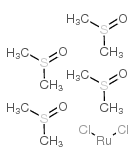cis-Tetrakis(dimethylsulfoxide)dichlororuthenium(II)
Modify Date: 2024-01-09 11:49:43

cis-Tetrakis(dimethylsulfoxide)dichlororuthenium(II) structure
|
Common Name | cis-Tetrakis(dimethylsulfoxide)dichlororuthenium(II) | ||
|---|---|---|---|---|
| CAS Number | 11070-19-2 | Molecular Weight | 484.51000 | |
| Density | N/A | Boiling Point | 189ºC at 760 mmHg | |
| Molecular Formula | C8H24Cl2O4RuS4 | Melting Point | N/A | |
| MSDS | N/A | Flash Point | 85ºC | |
| Name | tetrakis(dimethylsulfoxide)dichlororuthenium (ii) |
|---|---|
| Synonym | More Synonyms |
| Boiling Point | 189ºC at 760 mmHg |
|---|---|
| Molecular Formula | C8H24Cl2O4RuS4 |
| Molecular Weight | 484.51000 |
| Flash Point | 85ºC |
| Exact Mass | 483.89800 |
| PSA | 145.12000 |
| LogP | 4.82060 |
| Vapour Pressure | 0.805mmHg at 25°C |
|
Section 1: Product Identification Chemical Name:cis-Tetrakis(dimethylsulfoxide)dichlororuthenium (II), 98% CAS Registry Number:11070-19-2 Formula:C8H24Cl2O4RuS4 EINECS Number:none Chemical Family: Synonym:Dichlorotetrakis(dimethyl sulfoxide)ruthenium (II), Dichlorotetrakis(methylsulfoxide)ruthenium
Section 2: Composition and Information on Ingredients IngredientCAS NumberPercentACGIH (TWA)OSHA (PEL) Title Compound11070-19-2100%no datano data Section 3: Hazards Identification Emergency Overview:Irritating to skin, eyes and respiratory tract. Possible risk of irreversible effects. Primary Routes of Exposure:Ingestion, eyes Eye Contact:Causes slight to mild irritation of the eyes. Skin Contact:Causes slight to mild irritation of the skin. Inhalation:Irritating to the nose, mucous membranes and respiratory tract. Ingestion:Ingestion may lead to dizziness, abdominal cramps, and vomiting. Acute Health Affects:Irritating to skin, eyes and respiratory tract. Possible risk of irreversible effects. Chronic Health Affects:Possible risk of irreversible effects. NTP:No IARC:No OSHA:No SECTION 4: First Aid Measures Immediately flush the eyes with copious amounts of water for at least 10-15 minutes. A victim may need Eye Exposure: assistance in keeping their eye lids open. Get immediate medical attention. Wash the affected area with water. Remove contaminated clothes if necessary. Seek medical assistance if Skin Exposure: irritation persists. Remove the victim to fresh air. Closely monitor the victim for signs of respiratory problems, such as difficulty Inhalation: in breathing, coughing, wheezing, or pain. In such cases seek immediate medical assistance. Seek medical attention immediately. Keep the victim calm. Give the victim water (only if conscious). Induce Ingestion: vomiting only if directed by medical personnel. SECTION 5: Fire Fighting Measures Flash Point:none Autoignition Temperature:none Explosion Limits:none Extinguishing Medium:carbon dioxide, dry powder or foam Fire fighters should be equipped with a NIOSH approved positive pressure self-contained breathing apparatus Special Fire Fighting Procedures: and full protective clothing. Hazardous Combustion andIf involved in a fire this material may emit irritating fumes. Decomposion Products: Unusual Fire or Explosion Hazards: No unusual fire or explosion hazards. SECTION 6: Accidental Release Measures Spill and Leak Procedures:Small spills can be mixed with vermiculite or sodium carbonate and swept up. SECTION 7: Handling and Storage Handling and Storage:Store in a tightly sealed container. Keep away from heat, air and direct sunlight. SECTION 8: Exposure Controls and Personal Protection Eye Protection:Always wear approved safety glasses when handling a chemical substance in the laboratory. Skin Protection:Wear protective clothing and gloves. Consult with glove manufacturer to determine the proper type of glove. Ventilation:If possible, handle the material in an efficient fume hood. If ventilation is not available a respirator should be worn. The use of respirators requires a Respirator Respirator: Protection Program to be in compliance with 29 CFR 1910.134. Ventilation:If possible, handle the material in an efficient fume hood. Additional Protection:No additional protection required. SECTION 9: Physical and Chemical Properties Color and Form:yellow powder Molecular Weight:484.49 Melting Point:no data Boiling Point:no data Vapor Pressure:no data Specific Gravity:no data Odor:none Solubility in Water:insoluble SECTION 10: Stability and Reactivity Stability:air and moisture stable Hazardous Polymerization:no hazardous polymerization Conditions to Avoid:strong oxidizing agents Incompatibility:oxidizing agents, halogens and active metals Decomposition Products:carbon monoxide, carbon dioxide, organic fumes, and ruthenium oxide SECTION 11: Toxicological Information Intraperitoneal (mouse); LD50: 1gm/kg. Mutation in microorganisms (bacteria-Salmonella typhimurium): RTECS Data: 250ug/plate. Cytogenic analysis (hamster ovary); 6mmol/L Carcinogenic Effects:no data Mutagenic Effects:Possible mutagen Tetratogenic Effects:no data SECTION 12: Ecological Information Ecological Information:No information available SECTION 13: Disposal Considerations Disposal:Dispose of according to federal, state, and local regulations. SECTION 14: Transportation Shipping Name (CFR):Non-hazardous Hazard Class (CFR):NA Additional Hazard Class (CFR):NA Packaging Group (CFR):NA UN ID Number (CFR):NA Shipping Name (IATA):Non-hazardous Hazard Class (IATA):NA Additional Hazard Class (IATA):NA Packaging Group (IATA):NA UN ID Number (IATA):NA SECTION 15: Regulatory Information TSCA:Not listed in the TSCA inventory. SARA (Title 313):Title compound not listed. Second Ingredient:none SECTION 16 - ADDITIONAL INFORMATION N/A |
CHEMICAL IDENTIFICATION
HEALTH HAZARD DATAACUTE TOXICITY DATA
MUTATION DATA
|
| Risk Phrases | R36/37/38 |
|---|---|
| Safety Phrases | S26-36/37/39 |
| dichlorotetrakis(dimethylsulfoxide)rutheniumii |
| dichlorotetrakis(methylsulfoxide)ruthenium |
| dichlorotetrakis(methylsulfoxide)-rutheniu |
| dichlorotetrakis(sulfinylbis(methane))-rutheniu |
| dichlorotetrakis(sulfinylbis(methane))ruthenium |
| Ruthenium,dichlorotetrakis(methylsulfoxide) |